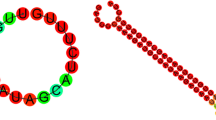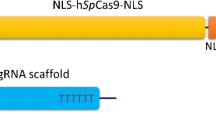Abstract
This experiment was conducted to explore the biological functions of myogenin (MyoG) gene. MyoG gene was cloned from genome of Hu sheep by overlap extension PCR. Then, pEGFP-C1–MyoG and pcDNA3.0–MyoG fusion expression vectors was constructed and pEGFP-C1–MyoG vector had been transfected into NIH-3T3 cells by liposomes-mediated method, and MyoG was detected in vitro by RT-PCR,western blotting and its subcellular localization by EGFP marker. pcDNA3.0–MyoG was transfected into goat embryonic fibroblasts (GEF) cells in order to detect the myogenic function of MyoG in vitro. Then pEGFP-C1–MyoG plasmid was injected into the testes of sheep and goat, respectively, to produce the transgenic generation. The results showed that the length of MyoG coding region of Hu sheep was 675 bp, encoding 224 amino acids. Compared with goat, cattle, pig and rat, the sequence homology of sheep MyoG cDNA was 99.26, 97.04, 92.00, and 87.70 %, respectively. The bioinformatics prediction showed that MyoG protein contained a typical bHLH structure, but without a short signal peptide, revealing that MyoG protein might be a non-secretory protein. The result of RT-PCR and western blotting demonstrated that MyoG could be expressed successfully in the transfected cells in vitro and the MyoG protein was located in nucleus. The positive transfected GEF cells with pcDNA3.0–MyoG were found to express desmin protein. The positive rates of transgenic sheep and transgenic goat were 7.1 and 7.4 % in F1 generation, respectively. Conclusively, MyoG cDNA from Hu sheep had been cloned successfully. The subcellular localization and myogenic activity of MyoG were exactly detected on the basis of multiple biological analyses, which expanded our understanding of the biological function of MyoG.










Similar content being viewed by others
References
TePas MF, Harders FL, Soumillion A, Born L, Buist W, Meuwissen TH (1999) Genetic variation at the porcine Myf5 gene locus. Lack of association with meat production traits. Mamm Genome 10:123–127
Hughes SM, Schiaffino S (1999) Control of muscle fiber size: a crucial factor in ageing. Acta Physiol Scand 167:307–312
Murre C, McCaw PS, Vaessin H, Caudy M, Jan LY, Jan YN, Cabrera CV, Buskin JN, Hauschka SD, Lassar AB, Wentraub H, Baltimore D (1989) Interactions between heterologous helix-loop-helix proteins generate complexes that bind specifically to a common DNA sequence. Cell 58(3):537–544
Naidu PS, Ludolph DC, To RQ, Hinterberger TJ, Konieczny SF (1995) Myogenin and MEF2 function synergistically to activate the MRF4 promoter during myogenesis. Mol Cell Biol 15(5):2707–2718
Olson EN (1990) MyoD family: a paradigm for development. Genes Dev 4:1454–1461
Sweetman D, Rathjen T, Jefferson M, Wheeler G, Smith TG, Münsterberg A, Dalmay T (2006) FGF-4 signaling is involved in mir-206 expression in developing somites of chicken embryos. Dev Dyn 235:2185–2191
Megeney LA, Rudinick MA (1995) Determination versus differentiation and the MyoD family of transcription factors. Biochem Cell Biol 73(9–10):723–732
Hasty P, Bradley A, Morris JH, Edmondson DE, Venuti JM, Olson EN, Klein WH (1993) Muscle deficiency and neonatal death in mice with a targeted mutation in the myogenin gene. Nature 364(6437):501–506
Nabeshima Y, Hanaoka K, Hayasaka M, Esumi E, Li S, Nonaka I, Nabeshima Y (1993) Myogenin gene disruption results in perinatal lethality because of severe muscle defect. Nature 364:532–535
Flynn JM, Meadows E, Fiorotto M, Klein WH (2010) Myogenin regulates exercise capacity and skeletal muscle metabolism in the adult mouse. PLoS One 5(10):e13535
Ye F, Tong H, Du W, Y YQ (2013) Research of inducing mouse embryonic stem cells differentiate into skeletal muscle cells in vitro. Chin J Cell Biol 35(3):273–281
Aguiar AF, Vechetti-Júnior IJ, Alves de Souza RW, Castan EP, Milanezi-Aguiar RC, Padovani CR, Carvalho RF, Silva MD (2013) Myogenin, MyoD and IGF-I regulate muscle mass but not fiber-type conversion during resistance training in rats. Int J Sports Med 34(4):293–301
Hinits Y, Osborn DPS, Hughes SM (2009) Differential requirements for myogenic regulatory factors distinguish medial and lateral somitic, cranial and fin muscle fibre populations. Development 136(3):403–414
Gao GY, Wang Wang Y, Fu CX, Zhou GM, Zhou LX, Wang CX (2009) Cloning and sequence analysis of MyoGenin of Chengdu grey goats. J Southwest Univ Natl 35(1):84–88
Liu ZZ, Zhang WX, Zhang CS, Gong YF, Liu XR (2009) Polymorphism analysis of the MyoG gene digested with Csp6I in goat. Acta Agriculturae Universitatis Jiangxiensis 31(2):317–321
Higuchi Russell (1990) PCR protocols: a guide to methods and applications. Recombinant PCR. Academic Press, New York
Moresi V, Williams AH, Meadows E, Flynn JM, Potthoff MJ, McAnally J, Shelton JM, Backs J, Klein WH, Richardson JA, Bassel-Duby R, Olson EN (2010) Myogenin and class II HDACs control neurogenic muscle atrophy by inducing E3 ubiquitin ligases. Cell 143:35–45
Meadows E, Cho JH, Flynn JM, Klein WH (2008) Myogenin regulates a distinct genetic program in adult muscle stem cells. Dev Biol 322(2):406–414
Piette J, Bessereau JL, Huchet M, Changeux JP (1990) Two adjacent MyoD1-binding sites regulate expression of the acetylcholine receptor alpha-subunit gene. Nature 345(6273):353–355
Lin H, Yutzey KE, Konieczny SF (1991) Muscle-specific expression of the troponin I gene requires interactions between helix-loop-helix muscle regulatory factors and ubiquitous transcription factors. Mol Cell Biol 11(1):267–280
Russo S, Tomatis D, Collo G, Tarone G, Tato F (1998) Myogenic conversion of NIH3T3 cells by exogenous MyoD family member: dissociation of terminal differentiation from myotube formation. Cell 111:691–700
Lawson-Smith MJ, McGeachie JK (1998) The identification of myogenic cells in skeletal muscle, with emphasis on the use of tritiated thymidine autoradiography and desmin antibodies. J Anat 192:161–171
Hao Jiang (2004) An experimental study on preventing denervated skeletal muscle atrophy by myogenin gene transfer. Fudan University Press, Shanghai
Yamazaki Y, Fujimoto H, Ando H, Ohyama T, Hirota Y, Noce Y (1998) In vivo gene transfer to mouse spermatogenic cells by deoxyribonucleic acid injection into seminiferous tubules and subsequent electroporation. Biol Reprod 59(6):1439–1444
Li FB, Wei H, Sun XM, Zhao YM (2005) Transfection of pEGFP-N1 gene into goat spermatozoa in vivo and its expression in early embryos after transfection. Acta Lab Anim Sci Sin 13(2):110–113
Acknowledgments
The study was supported by National New varieties of GMO cultivation of major projects (2011ZX08008-003; 2009ZX08008-003B) in China; A Project Funded by the Priority Academic Program Development of Jiangsu Higher Education Institutions.
Author information
Authors and Affiliations
Corresponding author
Additional information
Zhentao Zhang and Feng Xu have contributed equally to this study.
Rights and permissions
About this article
Cite this article
Zhang, Z., Xu, F., Zhang, Y. et al. Cloning and expression of MyoG gene from Hu sheep and identification of its myogenic specificity. Mol Biol Rep 41, 1003–1013 (2014). https://doi.org/10.1007/s11033-013-2945-0
Received:
Accepted:
Published:
Issue Date:
DOI: https://doi.org/10.1007/s11033-013-2945-0




